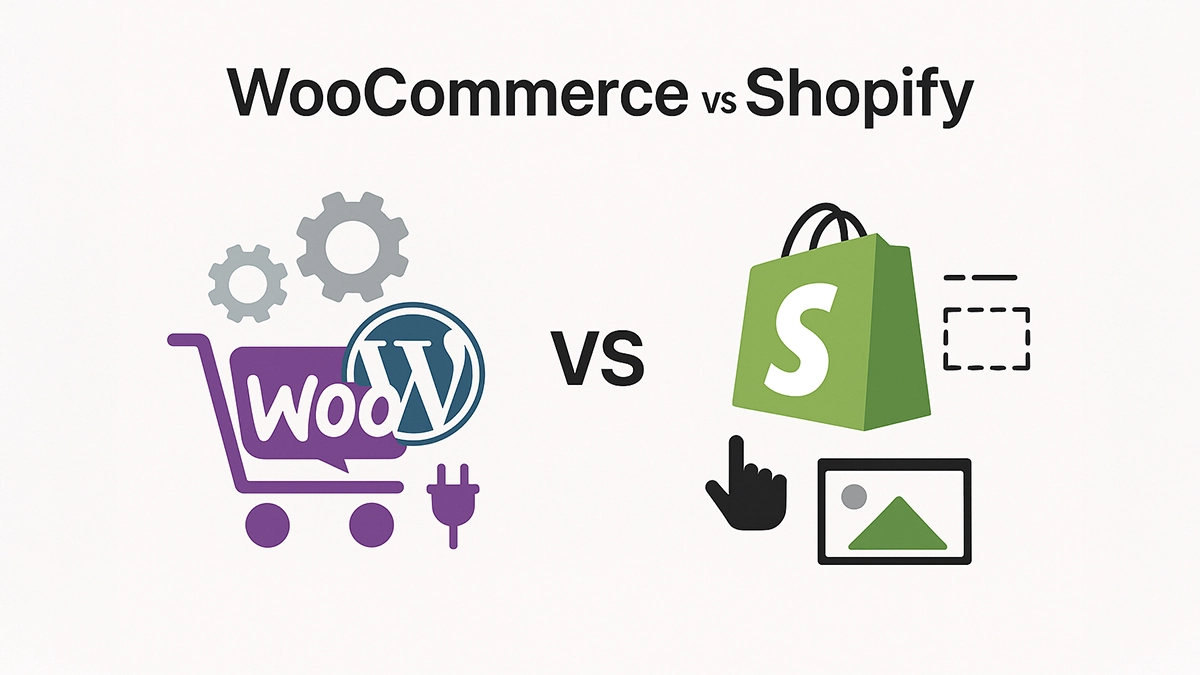Imagine being a small business owner setting up your first online store, only to encounter abandoned carts, plugin errors, and unexpected tech issues. This challenge is common for many entrepreneurs exploring e-commerce, looking for a solution to simplify their journey. When it’s time to start selling online, two names often come up: WooCommerce and Shopify. Both are extremely popular, but they approach online selling differently. For small businesses or startups, choosing wisely can mean a smooth journey or a struggle with tech problems and costs.
This guide is for both first-time store owners and brands thinking about switching platforms. We’ll break down what you need to know about WooCommerce and Shopify, including ease of use, pricing, SEO, scalability, and support, so you can decide which one fits your needs in 2025. Whether you’re starting your first store soon or seeking new growth opportunities, this guide offers the clarity you need.
- Why Choosing the Right E-Commerce Platform Matters
- What Is WooCommerce?
- What Is Shopify?
- Ease of Use
- Design and Customisation
- Features and Plugins
- SEO Capabilities
- Payment Options and Fees
- Pricing and Total Cost of Ownership
- Security and Hosting
- Scalability and Growth
- Support and Community
- Pros and Cons of WooCommerce vs Shopify
- Which Should You Choose?
Why Choosing the Right E-Commerce Platform Matters
Your e-commerce platform isn’t just a piece of software. It’s the foundation of your online business. A good platform will make it easy to:
- Build a store that looks professional
- Sell products seamlessly
- Optimise for search engines
- Handle payments securely
- Scale as your business grows
Choosing the wrong platform, however, can lead to unnecessary costs, technical headaches, and lost sales opportunities. That’s why the WooCommerce vs Shopify debate is so important.
| Criteria | Winner |
|---|---|
| Ease of use | Shopify |
| Design and Customisation | WooCommerce |
| Features & plugins | WooCommerce |
| SEO capabilities | WooCommerce |
| Payment Options and Fees | WooCommerce |
| Pricing and Total Cost of Ownership | WooCommerce |
| Security and Hosting | Shopify |
| Scalability and Growth | Tie |
| Support and Community | Tie |
What Is WooCommerce?
WooCommerce is a WordPress plugin that turns any WordPress website into a fully functional online shop. Launched in 2011, it has become one of the most widely used e-commerce solutions globally.
Key facts:
- It’s open-source and free to install.
- You’ll need your own hosting and domain.
- Flexibility is its biggest selling point – you can customise almost everything.
- It works seamlessly with thousands of WordPress themes and plugins.
WooCommerce is ideal for businesses that already use WordPress or want full control over their site.
What Is Shopify?

Shopify is a hosted e-commerce platform, founded in 2006, that allows you to create an online shop without worrying about hosting or technical setup.
Key facts:
- It’s subscription-based, with plans starting from around £25 per month.
- Hosting, security, and updates are included.
- It comes with a drag-and-drop store builder.
- It offers built-in payment processing.
Shopify is designed for ease of use, making it particularly attractive to startups and small businesses that lack technical expertise.
WooCommerce vs Shopify: Ease of Use
- WooCommerce:
Requires more setup. You’ll need to install WordPress, purchase hosting, and configure plugins. Although guides are available, beginners may find the process overwhelming at first. - Shopify:
Much easier for beginners. You can launch a store in a day with no technical expertise. The drag-and-drop builder simplifies design, and the platform handles hosting and security automatically.
Winner: Shopify wins on ease of use.
WooCommerce vs Shopify: Design and Customisation
- WooCommerce:
Offers thousands of themes and plugins. Because it’s open-source, developers can build custom features, giving you unlimited control over design and functionality. - Shopify:
Comes with a curated theme store, many of which are premium. Customisation is possible but limited compared to WooCommerce, unless you hire a developer.
Winner: WooCommerce takes the crown for flexibility, while Shopify offers polished, ready-made designs.
Looking for a custom designed website?
Check out our web design services
WooCommerce vs Shopify: Features and Plugins
- WooCommerce:
Integrates with over 50,000 WordPress plugins. From advanced product filters to marketing automation, the possibilities are almost endless. - Shopify:
Comes with powerful built-in features, and its App Store includes thousands of apps. However, many of the advanced features come at an extra monthly cost.
Winner: WooCommerce provides more options overall, but Shopify’s ecosystem is cleaner and more beginner-friendly.
WooCommerce vs Shopify: SEO Capabilities
- WooCommerce:
Excellent SEO flexibility. Since it runs on WordPress, you can use plugins like Yoast SEO or Rank Math to fine-tune everything. - Shopify:
Decent SEO features built in, but customisation is limited compared to WordPress. Technical SEO adjustments are harder to implement.
Winner: WooCommerce is better for SEO, especially if organic traffic is your main growth strategy.
read more
Is SEO Dead? An In-Depth Analysis
WooCommerce vs Shopify: Payment Options and Fees

- WooCommerce:
Supports hundreds of payment gateways, from PayPal to Stripe. Transaction fees depend on the provider, but WooCommerce doesn’t take a cut. - Shopify:
Has its own payment system (Shopify Payments) and integrates with third parties. However, if you don’t use Shopify Payments, you’ll pay extra transaction fees (up to 2%).
Winner: WooCommerce is more flexible and cost-effective when it comes to payment gateways.
WooCommerce vs Shopify: Pricing and Total Cost of Ownership
- WooCommerce:
The plugin is free, but you’ll need to pay for hosting, a domain, premium themes, and some plugins. Costs can vary widely – from £10 to £100+ per month, depending on your setup. - Shopify:
Clear monthly pricing, starting from around £25. Add-ons and apps can push this up significantly, especially as you grow.
Winner: WooCommerce can be cheaper in the long run, but Shopify offers predictable pricing.
WooCommerce vs Shopify: Security and Hosting
- WooCommerce:
You’re responsible for hosting and security. This means you’ll need SSL certificates, backups, and updates. Managed WordPress hosting can simplify this, but it adds to the cost. - Shopify:
Fully hosted with built-in SSL, PCI compliance, and automatic updates. Security is handled for you.
Winner: Shopify offers better peace of mind, while WooCommerce requires a hands-on approach.
WooCommerce vs Shopify: Scalability and Growth
- WooCommerce:
Scales as far as your hosting allows. With the right setup, it can support huge stores with thousands of products. - Shopify:
Scales easily as your business grows, but higher tiers (like Shopify Plus) are costly.
Winner: Both platforms scale well, but WooCommerce offers more control at potentially lower costs.
WooCommerce vs Shopify: Support and Community
- WooCommerce:
No official support, but a huge online community and documentation are available. Many hosting providers also offer WooCommerce-specific support. - Shopify:
24/7 customer support via chat, email, and phone. Less community-driven but reliable for direct help.
Winner: Shopify wins for customer support, but WooCommerce has a vast knowledge base.
Pros and Cons of WooCommerce vs Shopify
Shopify
| Shopify Pros | Shopify Cons |
|---|---|
| Easy to set up and use | Monthly fees add up |
| All-in-one solution (hosting, security, payments) | Limited customisation compared to WooCommerce |
| Reliable customer support | Extra transaction fees if not using Shopify Payments |
| Professional themes |
WooCommerce
| WooCommerce Pros | WooCommerce Cons |
|---|---|
| Free to start | Steeper learning curve |
| Highly customisable | Requires hosting and security management |
| Excellent SEO control | |
| Huge plugin ecosystem |
So, WooCommerce vs Shopify: Which Should You Choose?
- Choose WooCommerce if:
- You want maximum flexibility.
- SEO is a big part of your growth strategy.
- You’re comfortable with WordPress or willing to hire support.
- Choose Shopify if:
- You want a quick and easy way to start selling online.
- You don’t want to manage hosting or security.
- You value 24/7 customer support.
Final Thoughts
The WooCommerce vs Shopify decision ultimately comes down to control versus convenience. WooCommerce gives you flexibility, customisation, and SEO power. Shopify gives you simplicity, speed, and support.
For startups and small businesses, the choice depends on your priorities. If you want to launch fast with minimal hassle, Shopify might be the better option. If you’re building a long-term digital asset and value flexibility, WooCommerce is worth the extra effort.
Next Step: Take a moment to list your top three priorities and match them to the features and benefits outlined in this guide. This will help you turn insights into actionable steps for choosing the right platform for your business.


